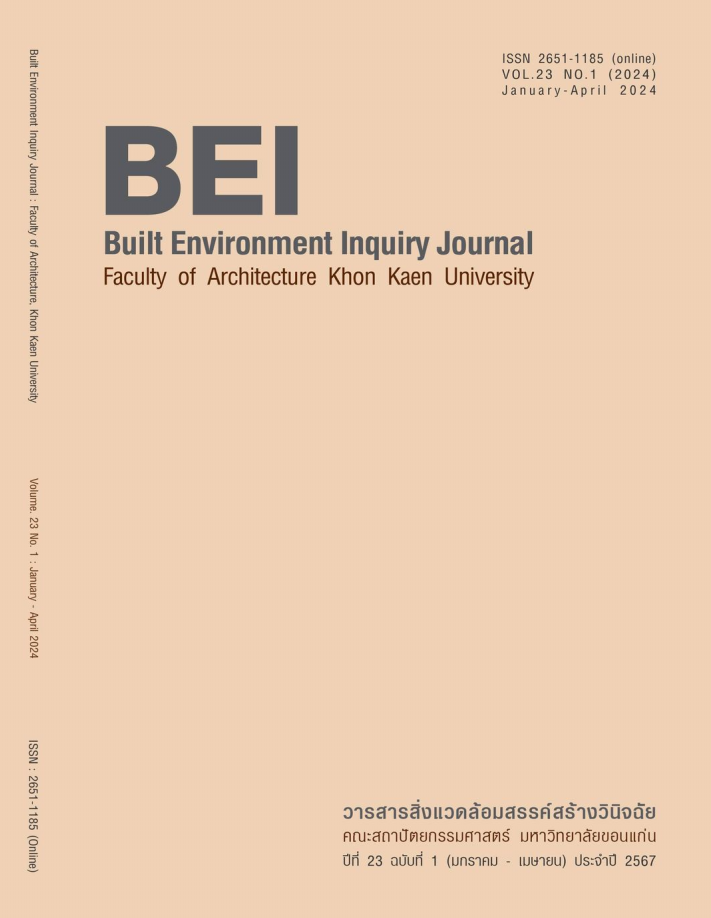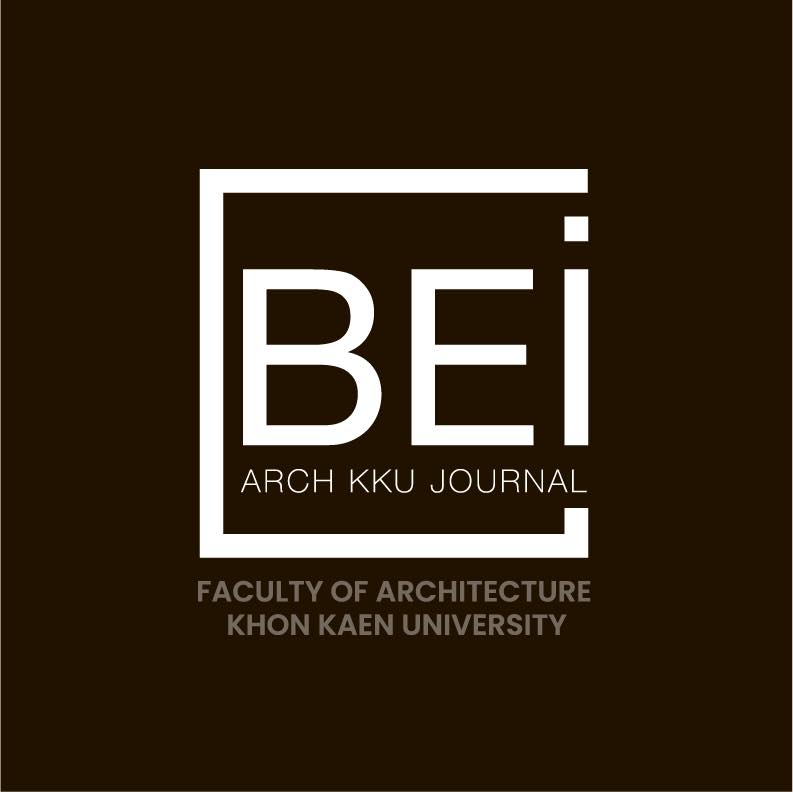ความรู้สึกที่มีต่อถิ่นที่ของสถาปัตยกรรมนอกระบบบนพื้นที่แบบไม่เป็นทางการ : กรณีีศึึกษา ตลาดร่มหุบ จังหวัดสมุทรสงคราม
DOI:
https://doi.org/10.14456/bei.2024.9คำสำคัญ:
พื้นที่แบบไม่เป็นทางการ, ความรู้สึกที่มีต่อถิ่นที่, ความพึงพอใจต่อถิ่นที่, สถาปัตยกรรมนอกระบบบทคัดย่อ
การวิจัยนี้มีวัตถุประสงค์เพื่อศึกษาบทบาทของสถาปัตยกรรมในพื้นที่แบบไม่เป็นทางการ ซึ่งในบทความนี้แทนด้วยคำว่า สถาปัตยกรรมนอกระบบ ที่ส่งผลถึงความรู้สึกที่มีต่อถิ่นที่ โดยมองผ่านการวิเคราะห์การรับรู้ และประสบการณ์ ของผู้ใช้พื้นที่ เพื่อทำความเข้าใจถึงการเกิดอัตลักษณ์ ปรากฏการณ์ และการคงอยู่ของพื้นที่ ซึ่งเป็นตัวบ่งชี้ถึง “ความเป็นถิ่นที่” ของพื้นที่แบบไม่เป็นทางการ ‘ตลาดร่มหุบ’จังหวัดสมุทรสงคราม เป็นพื้นที่ศึกษา ซึ่งเกิดปรากฏการณ์ของการยึดครองพื้นที่สาธารณะเพื่อการค้าขายข้างทางรถไฟ ส่งผลให้เกิดการซ้อนทับกันของพื้นที่ และหน้าที่ใช้สอย จนกลายเป็นพื้นที่สองความหมายในเวลาเดียวกัน การหุบ และกางร่มของร้านค้าเพื่อหลบจากการเคลื่อนเข้าและออกของขบวนรถไฟ ส่งผลต่อการเกิดขึ้นของ สถาปัตยกรรมนอกระบบ งานวิจัยนี้ใช้วิธีการวิจัยเชิงคุณภาพ และเชิงปริมาณ โดยการลงพื้นที่สังเกต สัมภาษณ์แบบไม่เป็นทางการ และเก็บข้อมูลโดยใช้แบบสอบถาม เพื่อวิเคราะห์ และสังเคราะห์ข้อมูล ผ่านกรอบแนวคิดเรื่องถิ่นที่ (Place) และความรู้สึกที่มีต่อถิ่นที่ (Sense of Place) ผลการวิจัยพบว่า ผู้ใช้งานพื้นที่มีความรู้สึกต่อความเป็นถิ่นที่ในระดับสูง และสถาปัตยกรรมนอกระบบถูกมองว่า ช่วยสร้างอัตลักษณ์ และนำไปสู่ความรู้สึกที่มีต่อถิ่นที่ ทั้งในด้านความผูกพันกับสถานที่ ความพึงพอใจ และความรู้สึกเกื้อหนุนในการเข้ามาใช้งานในพื้นที่ นำไปสู่การทำความความเข้าใจพื้นที่เพื่อใช้เป็นตัวอย่างในการต่อยอดการพัฒนาในพื้นที่อื่นๆที่มีรูปแบบและลักษณะของพื้นที่ที่คล้ายคลึงกันได้ต่อไป
เอกสารอ้างอิง
ขวัญสรวง อติโพธิ. 2548. ที่ว่างในสังคมไทย. บรรยายพิเศษคณะสถาปัตยกรรมศาสตร์ จุฬาลงกรณ์มหาวิทยาลัย. กรุงเทพฯ: จุฬาลงกรณ์มหาวิทยาลัย.
ไขศรี ภักดิ์สุขเจริญ. 2547. “วาทกรรมของเมืองผ่านโครงสร้างเชิงสัณฐาน”. วารสารวิชาการคณะสถาปัตยกรรมศาสตร์ฉบับภาควิชาการวางแผนภาคและเมือง, ปีที่(ฉบับที่ 2) : หน้า.63-76
ไชยรัตน์ เจริญสินโอฬาร. 2542. วาทกรรมการพัฒนา: อำนาจ ความรู้ ความจริง เอกลักษณ์และความเป็นอื่น. กรุงเทพฯ: วิภาษา.
ต้นข้าว ปาณินท์. 2553. คนและความคิดทางสถาปัตยกรรม. กรุงเทพฯ: โรงพิมพ์ภาพพิมพ์.
ระวิวรรณ โอฬารรัตน์มณี . 2557 “แนวคิดพื้นที่สาธารณะในมุมมองตะวันตกและตะวันออก”. ใน สันต์ สุวัจฉราภินันท์. (บรรณาธิการ). ว่าด้วยทฤษฎีทางสถาปัตยกรรม: พื้นที่สาธารณะและพื้นที่ทางสังคม. เชียงใหม่: มหาวิทยาลัยเชียงใหม่.
Atipho, K. 2005. Lan Mauang Pua Cheevit Satharana Lae Tong Tin Na Yoo. (In Thai) [Public Space for Public Life and Livable Communities]. Nation. 24 December 2005.
Brown, B. B., and D. D. Perkins. 1992. “Disruptions in Place Attachment.” In Place Attachment, edited by I. Altman, and S. M. Low, 279–304. New York: Plenum Press. https://doi.org/ 10.1007/978-1-4684-8753-4_13
Eyck, A.V. 1961. Het Verhaal van een Andere Gedachte (The Story of Another Thought). In: Forum 7/1959, Amsterdam and Hilversum.
Canter, D. 1971. The Psychology of Place. London: Architectural Press.
De Certeau, M. 1984. The practice of everyday life. Berkeley: University of California Press.
Eawsriwong, N. 2003. Pauen Tee Satharana Nai Sangkhom Thai. (In Thai) [Public Space in Thai Society]. Matichon Daily. 10 November 2003.
Foucault, M., 1986. “Diacritics”. In Rabinow, P. ed., The Foucault Reader. New York: Pantheon Books.
Gehl, J. and L. Gemzoe. 2002. Wining back the Public space. Conference lectured at the symposium
“(in)visible Cities. Spaces of Hope, Spaces of Citizenship”, Centre of Contemporary Culture of Barcelona, 25-27 July 2003, http://urban.cccb.org/urbanLibrary/htmlDocs/acrossCities_docViewer.aspMgldima=A&gDoc=A006-C.html&gPDF=A006-C.pdf
Habermas, J. 1989. The Structural Transformation of the Public Sphere: an Inquiry into a Category of Bourgeois Society. Cambridge: MIT Press.
Hashemnezhad, H., Yazdanfar, S. A, Heidari, A.A., and Behdadfar, N. (2013) Between sense and attachment: Comparing the concepts of place in architectural studies, Geografia. Malaysian Journal of Society & Space, 9(1).
Hawking, S. 1999. A Brief History of Time: From the Big Bang to Black Holes. Bantam Books. Great Britain.
Hidalgo, M. C., & Hernandez, B. 2001. Place attachment: conceptual and empirical questions. Journal
of Environment Pscychology, 21, 273–281.
Hay, R. 1998a. “A rooted sense of place in cross-cultural perspective. Canadian Geographer 42(3): 245–266.
Hernandez, B., M. Hidalgo, M. Salazar-Laplace and S. Hess. 2007. “Place attachment and place identity in natives and non-natives.” Journal of Environment Psychology 27(4): 310–319.
Jacobs J. 1961. The death and life of great American cities. Toronto: Random House.
Jacobson-Widding, A. 1983. Identity: Personal and Socio-Cultural : A Symposium. N.J., USA : Humanities
Press.
Jorgensen, B. and R. Stedman. 2001. “Sense of place as an attitude: Lakeshore owners’ attitudes toward their properties.” Journal of Environmental Psychology 21: 233–248.
Kyle, G., Graefe, A., & Manning, R. (2005). Testing the dimensionality of place attachment in recrea-
tional settings. Environment and Behaviour, 37(1), 153–177.
Lang, J. 1987 . Creating Architectural Theory: The Role of the Behavioural Sciences in Environmental Theory. New York: Van Nostrand Reinhold.
Larson, S., D. M. De Freitas and C. C. Hicks. 2013. “Sense of Place as a determinant of people’s attitudes towards the environment: Implications for natural resources management and planning in the Great Barrier Reef, Australia.” Elsevier Journal Environment Management 117: 226–234.
Leedy, P. D., & Ormrod, J. E. 2015. Practical research: Planning and design. 11th. ed. Boston:
Pearson.
Lefebvre, H. 1994. The Production of Space. Translated by Donald Nicholson- Smith. Oxford: Blackwell.
Lewicka, M. 2010. “What makes neighbourhood diferent from home and city? Efects of place scale on place attachment.” Journal of Environment Psychology 30(1): 35–51.
Low, S., & I. Altman. 1992. Place Attachment: A Conceptual Inquery. New York: Plenum.
Heidegger, M. 1962. Being and Time. Translate by John Macquarrie and Edward Robinson. London: SCM Press.
Manzo, L.C. 2005. For Better or Worse: Exploring Multiple Dimension of Place
Meaning. Journal of Environmental Psychology. 18: 5-29.
Massey, D. 1994. Space, Place and Gender. 3rd ed. Cambridge: Polity Press.
McGee, T.G. 1967. The Southeast Asian City: a Social Geography of the Primate Cities of Southeast Asia. New York: Frederick A. Praeger.
Mehrotra, R. 2003. Static spaces, kinetic places. Public Space in the Mega City of Bombay. Cities and Market Conference, IFHP World Congress Vienna.
Milligan, M. J. 1998. Interactional past and potential: The social construction of place attachment.
Symbolic Interaction, 21(1), 1–33.
Moore, R.L. and A.R. Graefe. 1994. Attachment to Recreation Settings: The Case of
Rail-Trail Users. Leisure Sciences. 16: 17-31.
Norberg-Schulz, C 1980. Genius Loci : Towards a Phenomenology of Architecture. New York: Rizzoli.
Proshansky, H. 1978. The self and the city. Environment and Behavior, 10(2), 147-169.
Proshansky, H. M., Fabian, A. K., & Kaminoff, R. 1983. Place identity: Physical world socialization of the
self. Journal Environment Psychology, 3, 57–83.
Punter, J. 1991. Participation in the design of urban space. Landscape Design, 200, 24–27.
Raymond, C. M., Brown, G., & Weber, D. 2010. The measurement of place attachment: Personal, community and environmental connections. Journal Environment Psychology, 30, 422–434.
Relph, E. 1976. Place and Placelessness. London: Pion.
Riley, R. 1992. Attachment to the ordinary landscape. In I. Altman and S. Low (Eds.), Place attachment (pp. 13-36), Plenum Press, New York.
Scannell, L. 2003. Natural and Civic Place Attachment and the Relation to Pro- Environmental Behaviours in Trail and Nelson. University of British Columbia.
Schreyer, R., G. Jacob and R. White. 1981. Environmental Meaning as a Determinant of Spatial Behaviour in Recreation, pp. 294-300. In J. Frazier & B. Epstein, eds. Proceeding of the Applied Geography Conferences, 4: 294–300. Kent State University, Ohio.
Seamon, D. and J. Sowers. 2008. “Place and Placelessness (1976): Edward Relph.” In Key Texts in Human Geography, edited by P. Hubbard, R. Kitchin, and G. Valentine, 43–51. London: Sage.
Shamai, S. 1991. “Sense of place: an empirical measurement.” Geoforum 22: 347-358.
Shamai, S., S. Arnon and I. Schnell. 2012. “From home to community and settlement: Sense of place in different scales.” Students Home Computer Science 6(3): 153–163.
Stedman, R. 2003. “Is it really just a social construction?: The contribution of the physical environment to sense of place.” Taylor & Francis Soceity & Natural Research 16(8): 671–685.
Steele, F. 1981. The sense of place. Boston: CBI Publishing Company, Inc.
Stoker, D. and S.A. Shumaker. 1981. People in Places: A Transactional View of Settings, pp.441-488. In J. Harvey, ed. Cognition, Social Behavior and the Environment. Hillsdale, Erlbaum, New Jersey.
Tansukanun, P. 2006. Kwam Mee Gab Kwam Pen Mauang Nai Siam. (In Thai) [Paradoxical Siamese Cities]. Journal of Mekong Societies, 2(2), 81-102.
Tuan, Y. F. 1990. Topophilia: A Study of Environmental Perceptions, Attitudes, and Values. New York. United States: Columbia University Press.
_______. 1974. Topophilia: A Study of Environmental Perception, Attitudes and Values. Morningside (Edition). New York: Colombia University Press.
_______. 1975. “Place: An Experiential Perspective.” Geographical Review 65(2): 151–165.
_______. 1977. Space and Place, the Perspective of Experience. Minneapolis: University of Minnesota Press.
Wallipodom, S. 2011. Pattanakarn Tang Sangkom-Wattanatham Thai. (In Thai) [Thai Socio-cultural Development ]. Bangkok: Muangboran.
Williams, R. 2009. “Place attachment, sense of belonging and identity in life history narratives of Iranian Baha’i refugees.” Baha’i Studies Review 15: 3–18.
Williams, D.R., M.E. Patterson, J.W. Roggenbuck and A.E. Watson. 1992. Beyond the commodity.
_______, and J.W. Roggenbuck. 1989. Measuring place attachment: Some preliminary results. In national recreation and park association research symposium on Leisure Research. October 20-22, 1989. San Antonio, Texas.
ดาวน์โหลด
เผยแพร่แล้ว
รูปแบบการอ้างอิง
ฉบับ
ประเภทบทความ
สัญญาอนุญาต
ลิขสิทธิ์ (c) 2024 สิ่งแวดล้อมสรรค์สร้างวินิจฉัย

อนุญาตภายใต้เงื่อนไข Creative Commons Attribution-NonCommercial-NoDerivatives 4.0 International License.
ทัศนะและข้อคิดเห็นของบทความที่ปรากฏในวารสารฉบับนี้เป็นของผู้เขียนแต่ละท่าน ไม่ถือว่าเป็นทัศนะและความรับผิดชอบของกองบรรณาธิการ




